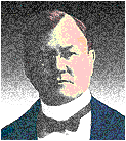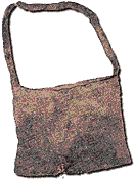
Early History of the Promotional Products Industry
Have you ever wondered how the promotional industry got its start? The first known promotional products in the United States are commemorative buttons, tracing back to 1789, when George Washington was elected president. Dating back to the early and mid 1800s are advertising calendars, wooden specialties and the Farmers’ Almanac. But it was not until the latter part of the 19th century that an abundance of promotional products were developed and marketed, leading to the birth of the industry as it is known today.

Jasper Freemont Meek was one of the earliest significant contributors to this budding industry. He owned a small newspaper in Coshocton, Ohio, and like many other small newspaper owners of the time, he supplemented his revenue by taking on job printing, which used his printing
press between editions.
Seeing a child drop her schoolbooks in the dirt on Main Street spurred Meek to approach his friend, Mr. Cantwell, owner of Cantwell Shoes, with an idea about building store traffic, name recognition and ultimately increasing sales. Meek’s idea was to imprint a burlap book bag with a simple but direct advertising message, “Buy Cantwell Shoes.”
Cantwell would give every child who came into his shoe store a free bag. The children would carry the bag as they walked to and from school so Cantwell’s name would be seen all over town. Mr. Meek manufactured the book bag, imprinted the advertising slogan on his printing press, and both Meek and Cantwell reaped the rewards.

After launching another successful promotional product—imprinted horse covers, seen on virtually every horse in town—Meek officially started his own innovative and successful promotional products company, the Tuscarora Advertising Co. He organized a sales force, who until 1889, would sell specialty items with practically no competition.
Ironically, Meek’s first competitor was Henry D. Beach, another small newspaper man in Coshocton, Ohio. Both men were aggressive and wanted to be the first to create new products by printing advertisements on anything that could be run through a printing press: cloth caps, aprons, hats for horses, bags for marbles, buggy whips, card cases, calendars and fans.
Beach was the first to take an interest in printing metal signs, and soon Meek became interested in the process as well. Both were aware that perfecting a printing process for metal would open up an entire new product line. Both succeeded, and although Beach managed the process first, both were successful, and proceeded to produce metal advertising trays (Coca-Cola® and some beer companies are the best known), which are collectors’ items today.
Two more newspaper owners, Thomas D. Murphy and Edward Burke Osborne, of Red Oak, Iowa, are credited with the birth of the art calendar in the late 1800s. Like Meek and Beach, they needed a business to keep their presses going and to bring in additional revenue. Osborne had an idea to print a watercolor painting of the new Red Oak courthouse on cardboard, place advertising around the painting, and then, attach a calendar pad. The calendar was an instant success, and even today, no home or office is without one.
Selling advertising space on calendars was not new, but until Murphy and Osborne, no one had thought of placing attractive art on the calendars. The men purchased photographs and paintings from a variety of artists. They also improved printing capabilities so that three-color images of original paintings could be printed. By 1894 Murphy and Osborne employed 94 people, including 14 traveling salesmen, and produced between two and three million calendars.
At the end of that same year Murphy and Osborne ended their partnership. Murphy sold his interest in the business to Osborne. Osborne went on to expand the business. In order to be closer to art and business centers, he moved the company to Newark, N. J., then established a pricing schedule and acquired a new printing process, now known as letter press printing. Osborne later expanded his highly successful calendar business worldwide, setting up plants in Toronto, London and Sydney, Australia.
History of the Association
In 1904 representatives of 12 promotional products manufacturers (manufacturers of advertising goods) agreed to form an industry trade association. The charter members addressed issues such as pricing, new ideas, business losses and managing salesmen, and adopted bylaws and operating procedures for the trade association. Benjamin S. Whitehead, owner of a promotional products manufacturing company in Newark, N.J., became the first president. The organization’s first name was the Advertising Manufacturers Association.
By 1906 the Association had 56 members and one honorary member, Henry S. Bunting, who published the Association’s official publication. Mr. Bunting’s publication, along with his book about promotional products and their impact on business growth, contributed greatly to the recognition of the industry. In 1912 the Advertising Federation of America designated ad specialties as a legitimate advertising medium.
Tradeshows became part of the Association’s conventions in 1914, with 32 exhibitors at the first show. Shows now play an integral role in the Promotional Products Association’s conventions held twice each year. At the winter show in 1999, there were more than 4,000 booths representing 1,400 exhibitors.
In 1928 the Association celebrated its 25th anniversary with more than 132 members. Now an influential trade association, the Association had accomplished many things in its first 25 years, including uniformity in terms and trade practices, and establishing advertising specialties as an advertising medium.
The industry was hit hard during the depression, but in the late 1940s business was again booming, with industry sales figures of $124 million recorded in 1947. In 1961 the Association began offering Executive Development seminars. In response to their popularity, the Association has continued to offer educational seminars to assist members with new ways to make their businesses more profitable and effective.
In 1966 membership was 1,211, and the number of exhibitors that year was more than 300. Today, membership is more than 10,500 with industry sales of $18.5 billion.
By the way …
Have you ever wondered how the pocket protector got its start? It was a promotional product designed to sell slip-on vinyl covers that protected loose-leaf binders.
This article incorporates text from a Promotional Products Association International publication: PPAI At 100, A Century Of Promoting Products, People, Places And Business, by Richard G. Ebel (2003)






